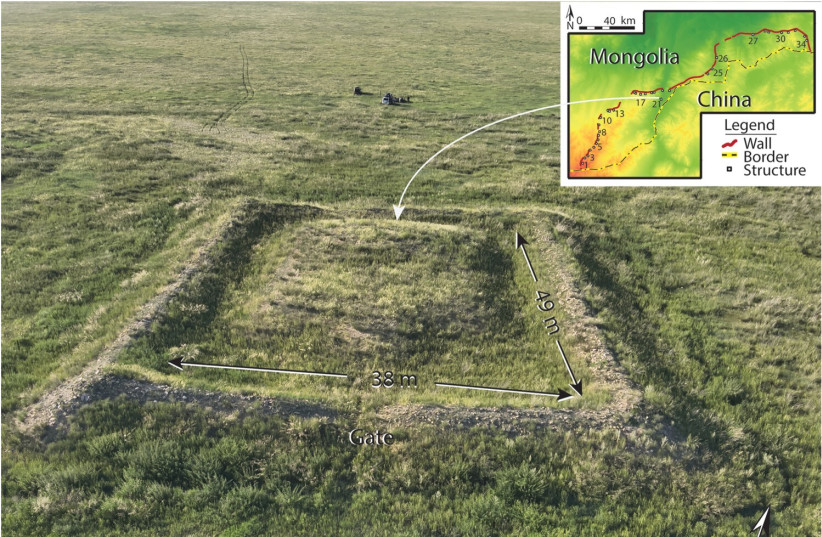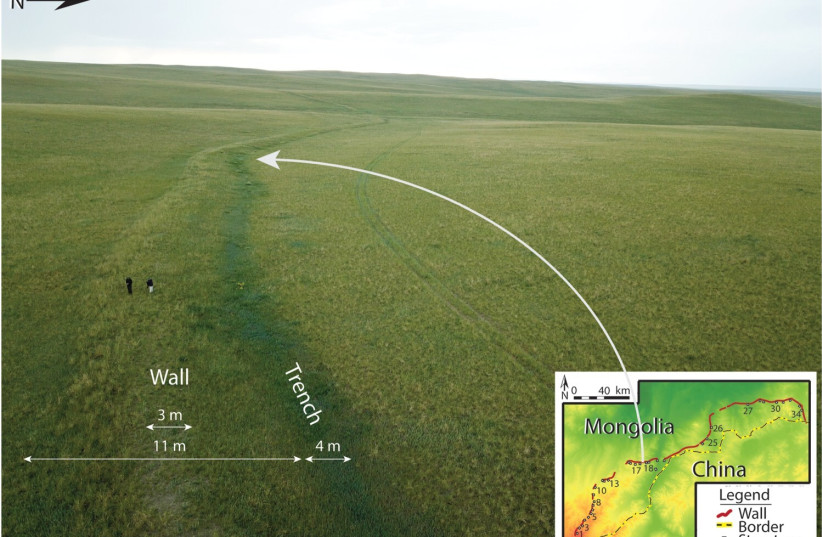China isn’t the only place on earth with a "Great Wall." So is Mongolia, about 2,700 kilometers from its southern neighbor's.

The researchers said this first-time discovery not only reveals the significance of this ancient architectural marvel, but also prompts crucial questions about the motives, functionality, and broader implications of such colossal constructions. Their findings contribute to a larger multidisciplinary project, exploring historical wall systems and their sociopolitical, economic, and environmental impacts, marking a pivotal milestone in understanding ancient civilizations and their enduring
legacies.
Hebrew University’s Gideon Shelach-Lavi, a professor of East Asian studies, and the National University of Mongolia’s Prof. Amartuvshin Chunag headed a team that unveiled a new discovery published in the Journal of Field Archaeology. Their paper, entitled “Unraveling the Mongolian Arc: A Field Survey and Spatial Investigation of a Previously Unexplored Wall System in Eastern Mongolia,” sheds light on a monumental wall system that has remained largely overlooked in existing academic discourse.
The Mongolian Arc comprises an earthen wall, a trench, and 34 accompanying structures. Constructed between the 11th and 13th centuries CE, this intricate system has emerged as a pivotal yet understudied facet of historical architectural marvels.
The research, conducted through a collaborative effort, involved a comprehensive approach, combining remote-sensing data collection, archaeological field surveys, and analysis through geographic information systems (GIS). The team also delved into ancient written sources to offer a preliminary interpretation of the design and potential functions of the Mongolian Arc.

The Arc and the Great Wall
“Understanding the significance of the Mongolian Arc unlocks profound insights into medieval wall systems, raising pertinent questions about the motives, functionality, and enduring consequences of such colossal constructions,” Shelach-Lavi wrote. “The questions we asked about this medieval wall system are relevant to other instances of wall construction: Why did some states and empires decide to invest massive amounts of resources and manpower in the construction of long border fencing, walls, and trenches? What were the intended functions of those monuments? How effective were they, and what were the social, political, economic, and environmental consequences of their construction? For how long did they function, and why were they abandoned?”
The Great Wall of China, the researcher wrote, “is not only the best-known example of ancient border walls, but it is also, arguably, one of the most extensively built monuments in human history.” However, “the Great Wall of China” is actually a misleading term. While long (or ‘great’) walls were constructed and used periodically throughout Chinese history, there were also long periods in which no such walls existed. Moreover, the location, function, and symbolic meaning of those walls varied dramatically from period to period. It is debated, for example, how effective the walls were and whether they were constructed to defend China against invasions from the north.”
The entire wall system to which the Mongolian Arc belongs has received different names in the research literature, they wrote, adding: “It has been called the ‘Jin border trench.’ It is also one of the most enigmatic long-wall and trench systems in the history of China and Mongolia. Despite its scale and complexity, it is unclear when exactly it was built, who built it, and for what purpose. It is not even clear whether the entire array of walls was built at the same time or if, as we now hypothesize, it is an accumulation of different projects built over a long period of
time.”
Their study is part of a larger multidisciplinary project, funded by a generous research fund from the European Research Council, addressing the construction of extensive walls and structures in northern China and eastern Mongolia about a millennium ago. The findings not only contribute to unraveling historical mysteries, but they also offer a framework for exploring the broader sociopolitical, economic, and environmental impacts of such endeavors.
The researchers said the published paper marked a pivotal milestone in the ongoing investigation, sparking renewed interest and further inquiry into ancient architectural wonders and their societal implications.
